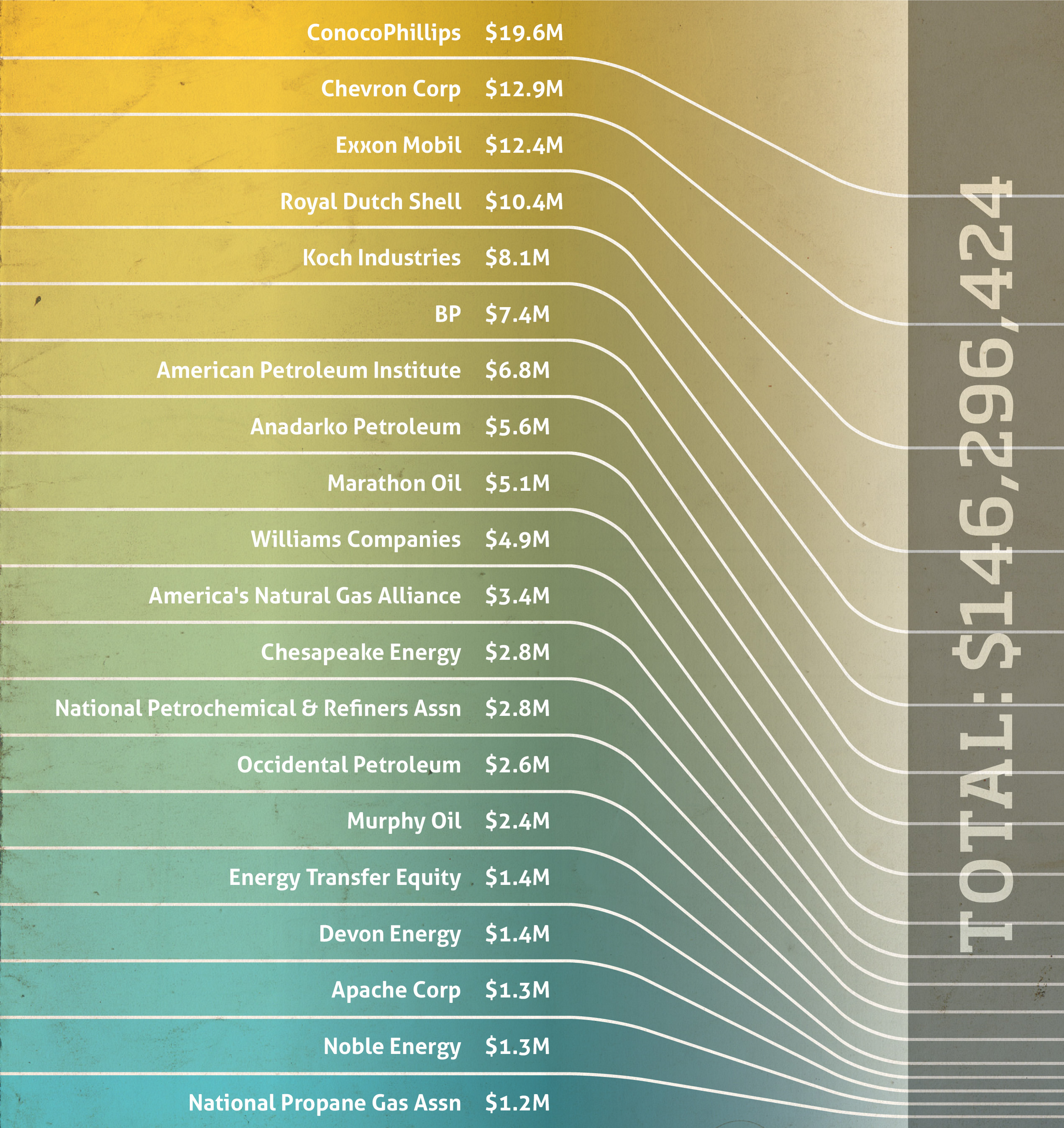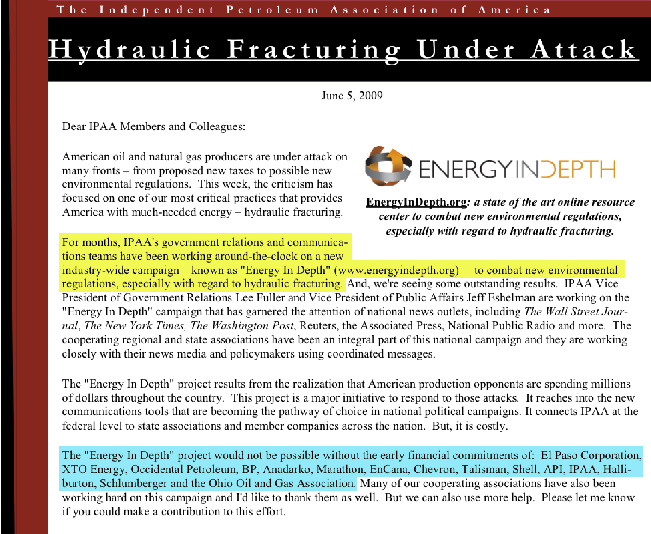
The gas lobby has been steadily increasing its presence in Washington, with industry sponsored groups such as American’s Natural Gas Alliance, the Independent Petroleum Association of America, the American Gas Association, and the Natural Gas Supply Association pushing for natural gas to become a mandated part of America’s “Clean Energy Standard.”[1][2] With an army of roughly 800 lobbyists, the gas network is working hard to secure its reputation against a history of poor practice and the fuel’s weakened position as a clean alternative.
But as much as lobbyists have attempted to separate gas from other dirty fossil fuels,[3] [4] the industry has emerged as a heavy polluter, contributing to a dramatic upswing in greenhouse gas emissions, poor air quality, drinking water contamination and toxic wastes. Even company investors have voiced their concerns over the liabilities posed by industry’s cavalier practices.[5] And despite widespread concerns over the dangers of natural gas drilling, regulatory agencies have demonstrated a history of placing industry concerns first, over public health and safety.

Industry front groups have released numerous reports attesting to the safety of gas extraction procedures and the supposed rigor of state oversight.[6] Some industry-friendly reports threaten that increased federal oversight of gas production would have catastrophic economic effects,[7] presenting to lawmakers and the public a misleading choice between the economy and environment.[8]
Companies such as BP, Shell Oil and ConocoPhillips have exerted pressure on senators to leave drilling regulation to the states.[9] Lawmakers, in exchange for supporting votes and campaign contributions, are cornered into making concessions on behalf of states reliant on oil and gas revenues.[10]
Gas hungry states are becoming a cornerstone in the lobbying enterprise. Recently the American Petroleum Institute, an industry group, coordinated a trip to Washington with 18 gas workers from six states to push House and Senate officials to prioritize industry growth.[11]
Politicians are now caught between an aggressive multi-million dollar industry campaign to separate gas from dirty energy sources like oil and coal,[12] and experts who caution against a large-scale switch to gas[13] because there is no guarantee that spending millions to commit to the fuel will have any climate or environmental benefits.[14]
In his 2011 State of the Union Address, President Obama sent clear signals that his administration has been swayed by the campaign when he cited gas as a part of the clean energy mix of the future. But the political clout demonstrated by the gas industry, now representing some of the world’s largest oil majors, threatens America’s true clean energy future by stifling the production of renewable energy.
The enormous lobbying expenditures made by industry groups to increase political pressure have translated into an inept regulatory structure, public misinformation campaigns, drinking water contamination, an abundance of toxic waste and climate pollution, all in the interest of prolonging the nation’s commitment to fossil fuels.
‘Energy In Depth’—Industry Front Group Funded By Major Oil and Gas Companies
‘Energy In Depth’ is the unconventional gas industry’s most vocal front group. It was created in 2009 to defend hydraulic fracturing and unconventional gas in the wake of a rising number of investigative media reports calling the industry’s risky practices into question.
Energy In Depth (EID) has spent the bulk of its first two years attacking the movie Gasland, as well as the excellent print and online reporting done by ProPublica[15], the Associated Press and, most recently, The New York Times in its “Drilling Down” series[16], all of which revealed significant problems with fracking and other unconventional gas activities.
From its earliest days, Energy In Depth has sought to project an image of itself as the voice for small, independent “mom and pop” gas companies.
EID’s chief spokesman, Chris Tucker, told a Pennsylvania radio host in an April 2010 interview:
“[Energy In Depth] was formed by independent natural gas producers—not the big boys—but the independent ones, the small ‘mom-and-pop’ shops across the country that really were at the forefront of developing this [fracking] technology that’s allowing us today to tap this shale.” [17]
That is consistent with how Energy In Depth describes itself on its ‘Contact Us’ page on its website:
“Energy In Depth is a project of America’s small, independent oil and natural gas producers...” [18]
But it isn’t true. While EID prefers to project this ‘mom and pop shop’ image, DeSmogBlog uncovered an industry memo[19] earlier this year revealing the group’s actual origins and seed funding. EID’s launch was a key component of a multimillion-dollar lobbying and public relations campaign by the largest oil and gas companies designed to defend fracking.
The June 2009 memo, entitled “Hydraulic Fracturing Under Attack,” was authored by Barry Russell, president of the Independent Petroleum Association of America (IPAA), who specifically listed and thanked the world’s largest oil and gas companies for enabling the creation of Energy In Depth, including BP, Halliburton, Chevron, Shell, Halliburton and XTO Energy (now owned by ExxonMobil).
The memo states: (see blue highlight)
“The “Energy In Depth” project would not be possible without the early financial commitments of: El Paso Corporation, XTO Energy, Occidental Petroleum, BP, Anadarko, Marathon, EnCana, Chevron, Talisman, Shell, API, IPAA, Halli- burton, Schlumberger and the Ohio Oil and Gas Association.”
However, none of these major oil and gas companies, nor the industry’s largest trade association—the American Petroleum Institute—are acknowledged on the ‘About Us’ page of Energy In Depth’s website.

From a November 2010 Energy In Depth “Weekly Update”
Instead, EID portrays its origins as far more modest, suggesting that its “website and affiliated educational programs were created by” a coalition of state-based oil and gas associations, whose logos are featured on its ‘About Us’ page. This is presumably designed to leave the impression that EID was launched by small, “independent petroleum producers” rather than by the largest oil and gas companies on the planet.
Further calling into question the alleged “mom and pop” origins of Energy In Depth, its website was created by Dittus Communications, a Washington DC public relations firm best known for its work for major tobacco and nuclear industry interests.[20] (Dittus is now part of Financial Dynamics, an international communications conglomerate.)
For a group that has accused Gasland director Josh Fox of creating an “alternate history,” and claims to be “setting the record straight” about the gas industry’s highly controversial practices, EID seems awfully disingenuous about its own origins and whose interests it truly represents.[21]
According to the 2009 memo, Energy In Depth was set up as a “major initiative to respond to…attacks” and to devise and circulate “coordinated messages” using “new communications tools that are becoming the pathway of choice in national political campaigns.”[22]
The memo reveals the key role that the Independent Petroleum Association of America played in launching Energy In Depth: (see yellow highlight)
“For months, IPAA’s government relations and communications teams have been working around-the-clock on a new industry-wide campaign – known as “Energy In Depth” (www.energyindepth.org) – to combat new environmental regulations, especially with regard to hydraulic fracturing.”
Two IPAA staffers, Lee Fuller and Jeff Eshelman, spearheaded the launch. Chris Tucker is also listed as staff on the ‘Contact Us’ page. Tucker did double duty in 2009 handling communications for Energy In Depth and the Institute for Energy Research, using the same phone number for both. (IER has received over $300,000 from ExxonMobil and an undisclosed amount from other oil and coal interests to confuse the public about climate change and to attack clean energy sources. For example, Danish journalists revealed last year that IER had bankrolled a study attacking the prospect of wind energy.[23])
More recently, Energy In Depth has continued to thank the largest oil and gas companies for providing its ongoing funding.
Below are two of the EID’s recent acknowledgements of its supporters. Note the dominance of major oil and gas companies and trade associations and the near total absence of anything that could honestly be called a small “mom and pop” company.

Photo: Ed Schipul, http://www.flickr.com/people/eschipul
[2]http://thehill.com/business-a-lobbying/84123-natural-gas-lobby-steps-up-to-challenge-coal?page=2#comments
[7]http://fossil.energy.gov/programs/oilgas/publications/environment_otherpubs/Oil_Gas_Environ_Proposals_Report_Jan_200.pdf
[11]http://www.nytimes.com/gwire/2011/03/08/08greenwire-natural-gas-companies-send-workers-to-hill-to-83229.html
[17]http://media.wilknewsradio.com/a/30268408/chris-tucker-spokesman-for-energy-in-depth-on-marcellus-shale-drilling.htm
[19]http://www.desmogblog.com/energy-depth-was-created-major-oil-and-gas-companies-according-industry-memo
[24]The New York Times, “Regulation Lax as Gas Wells’ Tainted Water Hits Rivers,” by Ian Urbina, February 26, 2011
[25]